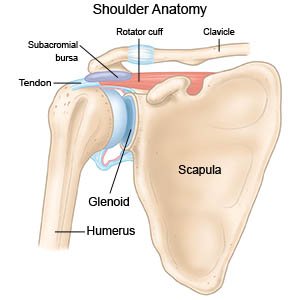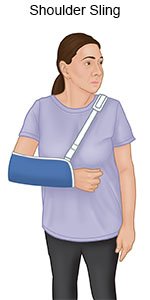Shoulder Sprain
Medically reviewed by Drugs.com. Last updated on Aug 4, 2025.
A shoulder sprain happens when a ligament in your shoulder is stretched or torn. Ligaments are the tough tissues that connect bones. Ligaments allow you to lift, lower, and rotate your arm.
 |
DISCHARGE INSTRUCTIONS:
Return to the emergency department if:
- You feel severe pain in your shoulder when you move it, or it is touched.
- Your skin feels cold or clammy.
- You have numbness, tingling, or a feeling of pins and needles in your shoulder.
- The skin on your injured shoulder looks blue or pale.
Call your doctor if:
- You have new or increased swelling and pain in your shoulder.
- You have new or increased stiffness when you move your injured shoulder.
- Your symptoms do not improve within 5 to 7 days.
- You have questions or concerns about your condition or care.
Medicines:
You may need any of the following:
- Acetaminophen decreases pain and fever. It is available without a doctor's order. Ask how much to take and how often to take it. Follow directions. Read the labels of all other medicines you are using to see if they also contain acetaminophen, or ask your doctor or pharmacist. Acetaminophen can cause liver damage if not taken correctly.
- NSAIDs , such as ibuprofen, help decrease swelling, pain, and fever. This medicine is available with or without a doctor's order. NSAIDs can cause stomach bleeding or kidney problems in certain people. If you take blood thinner medicine, always ask your healthcare provider if NSAIDs are safe for you. Always read the medicine label and follow directions.
- Prescription pain medicine may be given. Ask your healthcare provider how to take this medicine safely. Some prescription pain medicines contain acetaminophen. Do not take other medicines that contain acetaminophen without talking to your healthcare provider. Too much acetaminophen may cause liver damage. Prescription pain medicine may cause constipation. Ask your healthcare provider how to prevent or treat constipation.
- Take your medicine as directed. Contact your healthcare provider if you think your medicine is not helping or if you have side effects. Tell your provider if you are allergic to any medicine. Keep a list of the medicines, vitamins, and herbs you take. Include the amounts, and when and why you take them. Bring the list or the pill bottles to follow-up visits. Carry your medicine list with you in case of an emergency.
Follow up with your doctor as directed:
Write down your questions so you remember to ask them during your visits.
Self-care:
- Rest your shoulder so it can heal. Avoid moving your shoulder as your injury heals. This will help decrease the risk of more damage to your shoulder.
- Apply ice on your shoulder for 20 to 30 minutes every 2 hours or as directed. Use an ice pack, or put crushed ice in a plastic bag. Cover it with a towel before you apply it to your shoulder. Ice helps prevent tissue damage and decreases swelling and pain.
- Compress your shoulder as directed. Compression provides support and helps decrease swelling and movement so your shoulder can heal. For mild sprains, you may be given a sling to support your arm. You may need a padded brace or a plaster cast to hold your shoulder in place if the sprain is more serious.
How to wear a brace, sling, or splint:
A brace, sling, or splint may be needed to limit your movement and protect your injured shoulder.
 |
- Wear your brace, sling, or splint as directed. You may need to wear it all the time and take it off only to bathe or do exercises. Ask your healthcare provider how long you should wear it.
- Keep your skin clean and dry. Padding under your armpit will help absorb sweat and prevent sores on your skin.
- Do not hunch your shoulders. This may cause pain. Keep your shoulders relaxed.
- Position the sling over your arm and hand so that it also covers your knuckles. This will help the sling support your wrist and hand. Position your wrist higher than your elbow. Your wrist may start to hurt or go numb if your sling is too short.
Physical therapy:
A physical therapist teaches you exercises to help improve movement and strength, and to decrease pain.
Prevent another injury:
- Do not exercise when you are tired or in pain. Warm up and stretch before you exercise.
- Wear equipment to protect yourself when you play sports.
- Wear shoes that fit well and run on flat surfaces to prevent falls.
© Copyright Merative 2025 Information is for End User's use only and may not be sold, redistributed or otherwise used for commercial purposes.
The above information is an educational aid only. It is not intended as medical advice for individual conditions or treatments. Talk to your doctor, nurse or pharmacist before following any medical regimen to see if it is safe and effective for you.
Learn more about Shoulder Sprain
Care guides
Further information
Always consult your healthcare provider to ensure the information displayed on this page applies to your personal circumstances.
